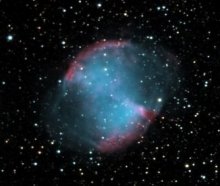
As you read the following information, you might think my life is mostly about astronomy. In fact, my wife and family, friends, church, and career (until I retired) are far more important, and other hobbies, travel, reading, etc. are just as
 important.
But since astronomy is more interesting to most of you reading this,
I've emphasized that and only touched on the other aspects of my life.
important.
But since astronomy is more interesting to most of you reading this,
I've emphasized that and only touched on the other aspects of my life.I've had a serious interest in astronomy since late elementary school. My first telescope of any size was a 3-inch Japanese artillery spotting scope. It was alt-az and the tripod had to be tilted to view above 45 degrees -- the zenith was unreachable. It was adequate for good views of the moon, a few planets, and my first 10-15 Messier objects. When I was 13 or 14, I ground a 6-inch mirror. It was supposed to be f/8 but turned out f/10.5. Except for the difficulty that caused in mounting, it was probably a fortunate error. My crude parabola still gave very decent images. Those were the days when it was still necessary to resilver mirrors every 6 months or so. I got a lot of practice at that. With that scope, I managed all the planets except Pluto, and another 10-15 Messier objects.
Astronomy faded into the background between late high school and graduation from college, except for making a couple of eyepieces in the college hobby shop. This was the first of several cycles, where I was very active for 5 years or so, and then inactive for a similar period. In the mid-60's, while living in the Philadelphia suburbs, I upgraded to a 6-inch f/8 Coulter mirror -- aluminized!! On a Edmund equatorial mount, it was a very satisfactory scope for many years. I kept adding Messiers but could never find my way through the Virgo galaxies.
Our next move was to the Chicago suburbs. Our town had an adult education program which allowed access to the high school machine shop, with bandsaws, lathes, welders, etc. I bought a 10-inch full thickness Coulter mirror, a 12 1/2-inch Parks tube, and built a sturdy fork mount, The head is 1/2-inch steel plate, with 2-inch pillow blocks and shaft, and the fork is 2 x 4 x 1/4 steel box. With some modifications, it's still my primary scope today (see Equipment). I added a number of additional Messiers to my list but the scope was not portable and galaxies were a stretch with the light pollution in that area.
In 1984, we moved to the Houston area, near Johnson Space Center. I took one look at the skies and decided that there was not going to be any astronomy there. For about eight years, my only observing of any significance was a family camping trip to Big Bend where we used the 6-inch for Halley's Comet. In 1991, I decided to build a Dobsonian base for the 10-inch optical tube, with the idea of making it portable for trips to dark sky locations. When I tried it out, I was pleasantly surprised by how much I could see from my house. Very few galaxies were visible but open and globular clusters, and planetary nebulae, were easy. And I realized that variable stars were almost unaffected by the light pollution, so they became the focus of my home observing. Also in 1991, I joined the Johnson Space Center Astronomical Society. I attended my first Texas Star Party in the spring of 1992 and have only missed three since. I completed my Messier list at that first TSP and then started the Herschel 400, completing it in 1995. However, I didn't get around to submitting my observations until 2004 so I received Herschel Award Number 307 instead of something around 100. In 1995, I built a Cookbook 245 and have been hooked on CCD imaging ever since.
As far as my "other life" is concerned, I graduated from high school in Indiana and went to MIT, where I got both a S.B. and S.M. in Industrial Management. I graduated in 1963, married Nancy Solander, and took a job with Sun Oil Company. My division of Sun was acquired by Amoco in 1968 and I spent the remainder of my 35 year career with Amoco Chemicals. I retired in 1998. Nancy and I have three children, and now have seven grandchildren as well.










